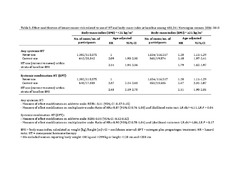Blar i forfatter "Sandvei, Marie Søfteland"
-
Menopausal hormone therapy and breast cancer risk: effect modification by body mass through life
Sandvei, Marie Søfteland; Vatten, Lars Johan; Bjelland, Elisabeth Krefting; Eskild, Anne; Hofvind, Solveig; Ursin, Giske; Opdahl, Signe (Journal article; Tidsskriftartikkel; Peer reviewed, 2018-08-06)It is not known whether increased breast cancer risk caused by menopausal hormone therapy (HT) depends on body mass patterns through life. In a prospective study of 483,241 Norwegian women aged 50–69 years at baseline, 7656 women developed breast cancer during follow-up (2006–2013). We combined baseline information on recalled body mass in childhood/adolescence and current (baseline) body mass index ... -
A national intercalated medical student research program–student perceptions, satisfaction, and factors associated with pursuing a PhD
Sandvei, Marie Søfteland; Jacobsen, Geir Wenberg; Stien, Marianne Heldal; Ræder, Helge; Munthe, Ludvig Andre; Skogen, Vegard (Journal article; Tidsskriftartikkel; Peer reviewed, 2022-09-07)Background - To counteract a decreasing number of physician-scientists, a national intercalated Medical Student Research Programme (MSRP) was launched in Norway in 2002. We aimed to assess whether the students’ favourable perceptions and satisfaction with the program had prevailed since the inception in 2002 and until 2015, and to identify factors associated with pursuing a PhD.<p> <p>Methods - ... -
Obesity does not protect from subarachnoid haemorrhage: Pooled analysis of 3 large prospective Nordic cohorts
Rautalin, Ilari; Kaprio, Jaakko; Ingebrigtsen, Tor; Jousilahti, Pekka; Løchen, Maja-Lisa; Romundstad, Pål Richard; Salomaa, Veikko; Vik, Anne; Wilsgaard, Tom; Mathiesen, Ellisiv B.; Sandvei, Marie Søfteland; Korja, Miikka (Journal article; Tidsskriftartikkel; Peer reviewed, 2021-11-10)Background and purpose: Several population-based cohort studies have related higher body mass index (BMI) to a decreased risk of subarachnoid hemorrhage (SAH). The main objective of our study was to investigate whether the previously reported inverse association can be explained by modifying effects of the most important risk factors of SAH—smoking and hypertension.<p> <p>Methods: We conducted ...


 English
English norsk
norsk

